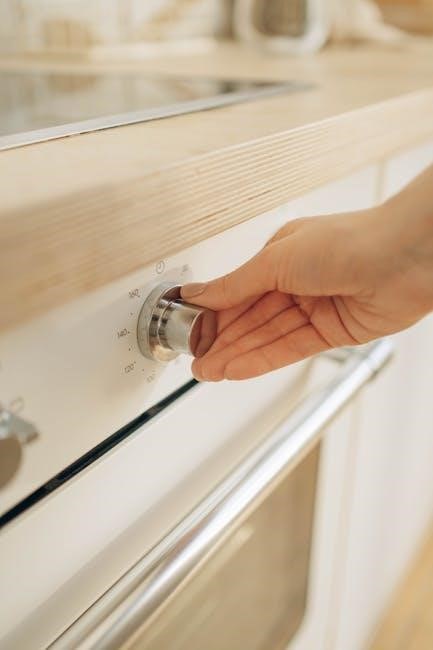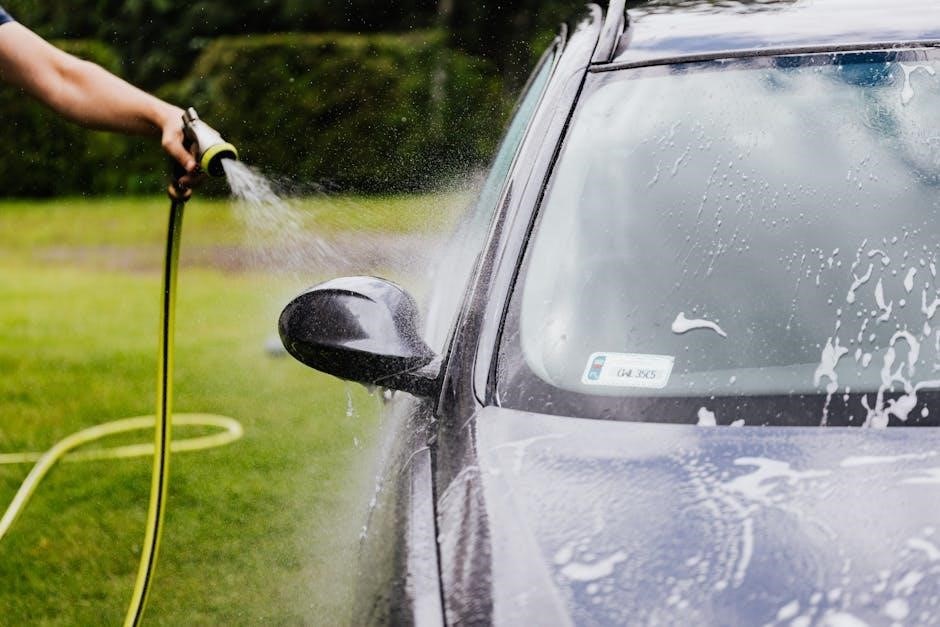General Electric water softener manuals provide comprehensive guides for installation, maintenance, and troubleshooting. They cover models like GXSF30V00 and GXSH40V00, offering detailed diagrams and repair tips. These resources ensure optimal performance and address common issues, helping users resolve problems efficiently. Manuals are available online through official GE websites and trusted sources like ManualsLib and PartSelect.
1.1 Overview of General Electric Water Softeners
General Electric water softeners are designed to reduce water hardness by removing minerals like calcium and magnesium. Models such as the GXSF30V00 and GXSH40V00 offer high-efficiency systems with advanced features like automatic regeneration. These systems are known for their reliability and user-friendly interfaces. They cater to various household needs, ensuring softened water for better appliance performance and skin care. GE water softeners are also energy-efficient and designed for low maintenance, making them a popular choice for homes seeking improved water quality solutions.
1.2 Importance of Using the Manual
Using the General Electric water softener manual is essential for proper installation, maintenance, and troubleshooting. It provides model-specific instructions, ensuring optimal performance and longevity. The manual includes detailed diagrams, repair tips, and part identification, helping users address common issues like water not softening or salt bridges. By following the guide, users can avoid costly repairs and ensure efficient operation. It also serves as a reference for understanding advanced features and maintaining water quality, making it a vital resource for homeowners seeking to maximize their system’s potential.

Installation and Setup Guide
This guide offers step-by-step installation instructions for models like GXSF30V00 and GXSH40V00. Find pre-installation requirements and setup tips in official GE manuals, available as PDF downloads.
2.1 Pre-Installation Requirements
Before installing your GE water softener, ensure you have adequate space and a suitable location. Check the water supply lines, electrical connections, and drainage options. Verify compatibility with your home’s plumbing system and water type. Refer to the manual for specific models like GXSF30V00 or GXSH40V00. Gather necessary tools and materials, including a drain hose and salt for initial setup. Ensure the area is clear and accessible for a smooth installation process. Proper preparation ensures a hassle-free setup and optimal performance of your water softener system.
2.2 Step-by-Step Installation Instructions
Start by unpacking and positioning the water softener unit in a suitable location. Connect the inlet and outlet hoses to the appropriate ports, ensuring correct alignment. Plug in the power cord and set the time on the electronic control board. Add salt to the brine tank and fill the resin tank with water. Refer to the manual for specific instructions for models like GXSF30V00 or GXSH40V00. Follow the sequence carefully to avoid leaks or electrical issues. Consult the manual for part numbers like PS8759105 if replacements are needed. Proper installation ensures efficient water softening performance.
2.3 Initial Setup and Configuration
After installation, set the time on the electronic control board and configure water hardness levels according to your preferences. Initialize the system by running a manual regeneration cycle to ensure proper function. For models like GXSF30V00 or GXSH40V00, refer to the manual for specific settings. Check the float stem and guide (part number PS8759145) to ensure water level control. Proper configuration ensures optimal performance and prevents issues like overfilling or malfunctioning. Follow the manual’s guidelines for initial setup to avoid common problems.

Maintenance and Care Tips
Regular maintenance ensures optimal performance. Check salt levels, clean the brine tank, and inspect the control board. Address issues promptly to prevent system malfunctions.
3.1 Regular Maintenance Tasks
Regular maintenance ensures your GE water softener operates efficiently. Check salt levels monthly and refill as needed. Clean the brine tank every 1-2 years to prevent salt bridges. Inspect the control board for errors and ensure all wires are secure. Replace worn-out parts like the float stem or valve seals promptly. Refer to your model-specific manual for detailed instructions. Routine care prevents issues like water not softening or system malfunctions, ensuring consistent performance and longevity of your water softener.
3.2 Cleaning and Sanitizing the System
Cleaning and sanitizing your GE water softener system is essential for optimal performance. Start by cleaning the resin bed every 2-3 years to remove dirt and impurities. Use a resin cleaner designed for water softeners and follow the instructions in your manual. Sanitize the system by adding chlorine or a sanitizing solution to the brine tank. Allow it to cycle through the system before rinsing thoroughly. Regular cleaning prevents bacterial growth and ensures soft water quality. Refer to your model-specific manual for detailed cleaning procedures.
3.4 Troubleshooting Common Maintenance Issues
Common maintenance issues with GE water softeners include system not regenerating, salt bridges, and electronic control board malfunctions. Check the control board for error codes and reset it if necessary. Salt bridges can be resolved by breaking up the salt crust and ensuring proper humidity. If the float stem or guide is faulty, replace it using part PS8759145. Regularly inspect and clean the venturi valve and drain line to ensure proper water flow and regeneration. Refer to your manual for specific troubleshooting steps for your model.

Troubleshooting Common Problems
Identify and resolve issues like water not softening, salt bridges, or tank overfilling. Check the electronic control board, float stem, and venturi valve for malfunctions. Refer to your manual or online resources for model-specific solutions and repair tips to ensure optimal performance and address problems promptly. GE manuals provide detailed guidance for diagnosing and fixing common issues effectively.
4.1 Water Not Softening
- If your GE water softener isn’t producing soft water, check for low salt levels or a salt bridge in the brine tank.
- Ensure the softener is programmed with the correct water hardness setting.
- Inspect the venturi valve for blockages, as this can disrupt water flow and regeneration.
- Verify the ion exchange resin isn’t exhausted or damaged, requiring replacement.
- Consult your manual for model-specific troubleshooting steps, such as resetting or reinitiating regeneration cycles.
- Refer to part numbers like PS8759105 for potential electronic control board issues if the problem persists.
4.2 Salt Bridge Issues
A salt bridge in your GE water softener occurs when a crust forms in the brine tank, preventing salt from dissolving. This disrupts regeneration, reducing softening efficiency. To fix it:
- Manually break the salt bridge with a stick or broom handle.
- Clean the tank thoroughly and ensure proper salt levels.
- Regularly inspect and maintain the brine tank to prevent reoccurrence.
Refer to your manual for model-specific guidance on addressing salt bridge problems and ensuring optimal softener performance.
4.3 Tank Filling Up with Water
If your GE water softener tank is filling with water, it may indicate a malfunction in the float valve or drain system. Check for blockages in the drain hose or faulty float mechanisms. Ensure the overflow tube is correctly positioned and not clogged. Refer to your manual for specific instructions on adjusting or replacing parts like the float stem or guide. If issues persist, consult a professional or replace faulty components to restore proper function and prevent water overflow.
4.4 Electronic Control Board Malfunctions
An electronic control board malfunction can cause the water softener to stop functioning properly. Symptoms include error codes, system freezing, or the unit not responding to commands. Check for loose connections or damaged wiring. If issues persist, the control board may need replacement. Refer to your manual for part numbers like PS8759105. Resetting the system or consulting a professional can resolve complex malfunctions. Ensure proper installation and maintenance to prevent future electronic failures and maintain optimal water softening performance.

Model-Specific Information
This section provides detailed specifications and features for various GE water softener models, including GXSF30V00, GXSH40V00, and GXSF39E01, helping users understand their specific unit’s capabilities.
5.1 GE GXSF30V00 Model Details
The GE GXSF30V00 is a 30,400 Grain Water Softener designed for efficient operation. It features advanced technology to minimize salt usage and reduce maintenance. This model is ideal for small to medium-sized households, offering reliable performance. The GXSF30V00 includes a digital control panel for easy settings and monitoring. It is part of GE’s popular water softener lineup, known for durability and quiet operation. Detailed specifications and repair parts for this model are available online through resources like PartSelect and ManualsLib.
5.2 GE GXSH40V00 Model Specifications
The GE GXSH40V00 is a 40,000 Grain Water Softener, suitable for medium to large households. It features smart technology to detect water usage patterns, optimizing salt consumption. This model includes a digital control panel for easy adjustments and monitoring. The GXSH40V00 is designed for high efficiency, reducing salt usage while maintaining soft water quality. It is part of GE’s advanced lineup, known for reliability and quiet operation. Detailed specifications and repair guides for this model are available online through sources like PartSelect and ManualsLib.
5.3 GE GXSF39E01 Model Features
The GE GXSF39E01 model is a high-efficiency water softener with advanced features. It has a 39,000-grain capacity, making it suitable for larger households. This model includes smart technology to monitor water usage and optimize salt consumption. The GXSF39E01 also features a user-friendly digital control panel for easy adjustments. It is designed for quiet operation and long-term reliability. Detailed diagrams and repair parts for this model are available through resources like PartSelect, ensuring easy maintenance and troubleshooting.

Repair and Replacement Parts
GE water softener repair parts include control boards, valves, and salt bridges. Model-specific components like PS8759105 are available through official GE resources and trusted retailers.
6.1 Common Replacement Parts
Common replacement parts for GE water softeners include electronic control boards, float stems, and salt bridge components. The PS8759105 control board manages system functions, while the PS8759145 float stem regulates water levels. Other essential parts include valves, seals, and resin tanks. These components ensure proper water softening and system efficiency. Replacing worn or faulty parts with genuine GE or compatible alternatives is crucial for maintaining performance. Always refer to the official manual or trusted retailers like PartSelect for authentic parts.
6.2 Part Number Identification
Identifying part numbers for GE water softeners is crucial for accurate replacements. Numbers like PS8759105 for control boards and PS8759145 for float stems are specific to functions. These numbers are usually found on the part itself, in the manual, or on the manufacturer’s website. Using model-specific diagrams from sources like PartSelect helps ensure correct identification. Always cross-reference with the model number to avoid ordering incorrect parts, ensuring proper system function and longevity. Double-checking ensures compatibility and avoids return hassles.
6.3 DIY Repair Tips
DIY repairs for GE water softeners can save time and money. Start by unplugging the unit to reset the system. For issues like stuck valves, clean the venturi valve or replace it if damaged. If the float stem malfunctions, check for blockages or replace it using part numbers like PS8759145. Always refer to model-specific diagrams for guidance. For electronic control boards, ensure proper wiring connections. If unsure, consult the manual or online resources for step-by-step instructions. DIY repairs are cost-effective but ensure safety by following proper procedures.

Owner Manuals and Downloads
GE water softener manuals are available online, including models like GXSF30V and GXSH40V. Download PDF guides from ManualsLib or PartSelect for installation and repair details.
7.1 Accessing the Official GE Water Softener Manual
To access the official GE water softener manual, visit the GE Appliances website or trusted platforms like ManualsLib. Enter your model number, such as GXSF30V or GXSH40V, to download the PDF guide. These manuals include detailed installation instructions, maintenance tips, and troubleshooting solutions. Supplementary resources like diagrams and repair guides are also available on PartSelect. Ensure you have the correct model number for accurate information to maintain your water softener’s optimal performance.
7.2 Installation Instructions for Specific Models
GE provides detailed installation instructions for specific water softener models, such as GXSF30V and GXSH40V. These guides, available on ManualsLib and PartSelect, cover unpacking, plumbing connections, and electrical setup. Follow step-by-step instructions for mounting the system, connecting pipes, and configuring settings. Ensure all components are properly aligned and secured. Refer to your model’s manual for precise instructions, as procedures may vary slightly between models. Proper installation ensures efficient operation and longevity of your water softener system.
7.3 Supplementary Guides and Resources
Supplementary guides and resources for GE water softeners include model-specific repair manuals, instructional videos, and symptom-based troubleshooting. Websites like PartSelect and ManualsLib offer detailed diagrams, OEM part lists, and step-by-step repair instructions. These resources help users identify and resolve common issues, such as salt bridges or electronic malfunctions. Additional guides provide tips for maintenance,salt usage optimization, and system upgrades. These resources empower users to perform DIY repairs and maintain their water softeners effectively, ensuring optimal performance and longevity of the system.
General Electric water softener manuals are essential for ensuring optimal performance and longevity of the system. They provide detailed guidance for installation, maintenance, and troubleshooting, covering common issues like water not softening or salt bridges; Supplementary resources, including model-specific diagrams and repair tips, empower users to resolve problems efficiently. By following the manual and utilizing available guides, users can enjoy softened water while extending the life of their GE water softener. Proper maintenance ensures reliability and efficiency, making these manuals invaluable for homeowners.
